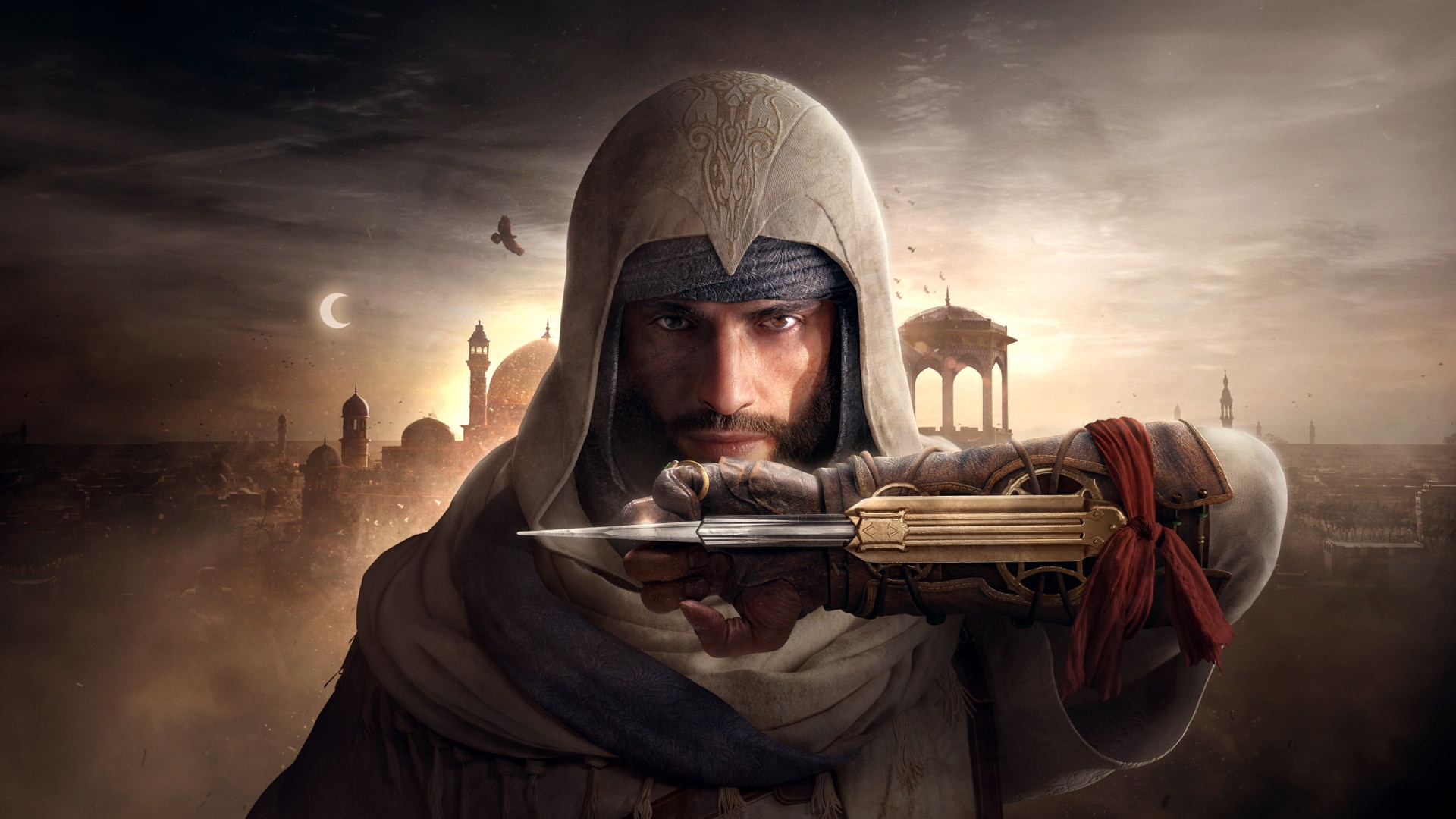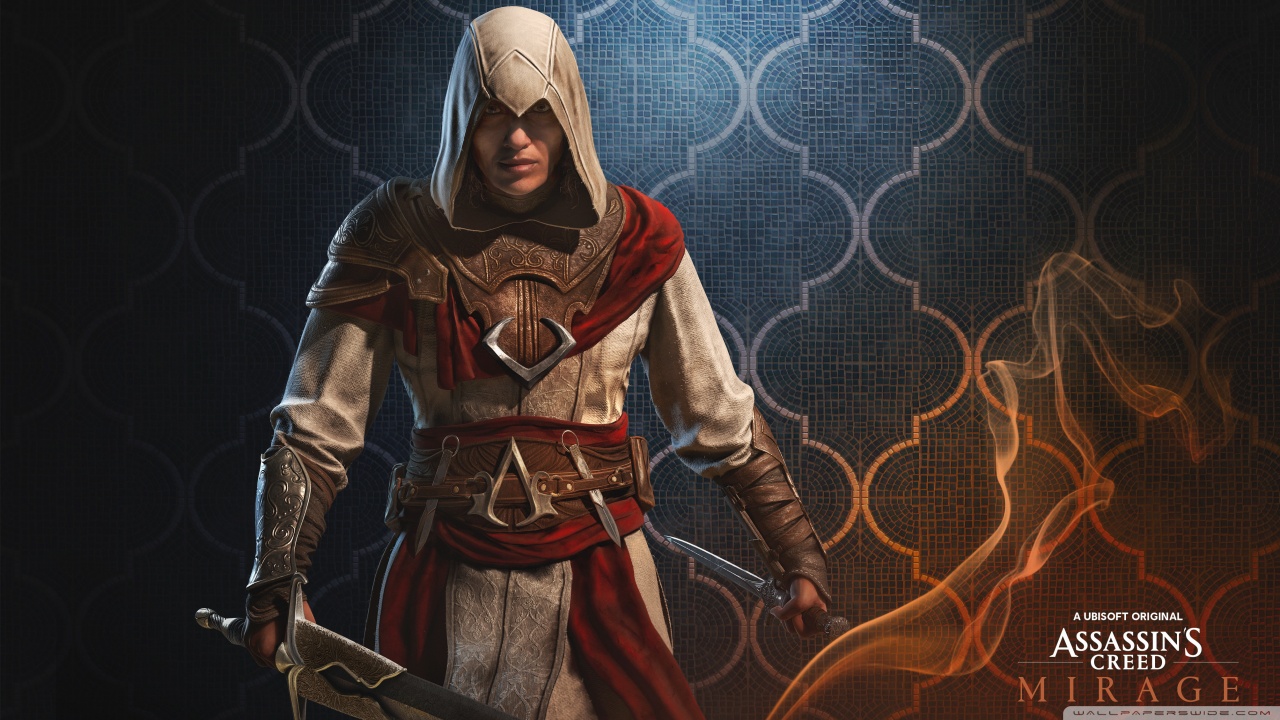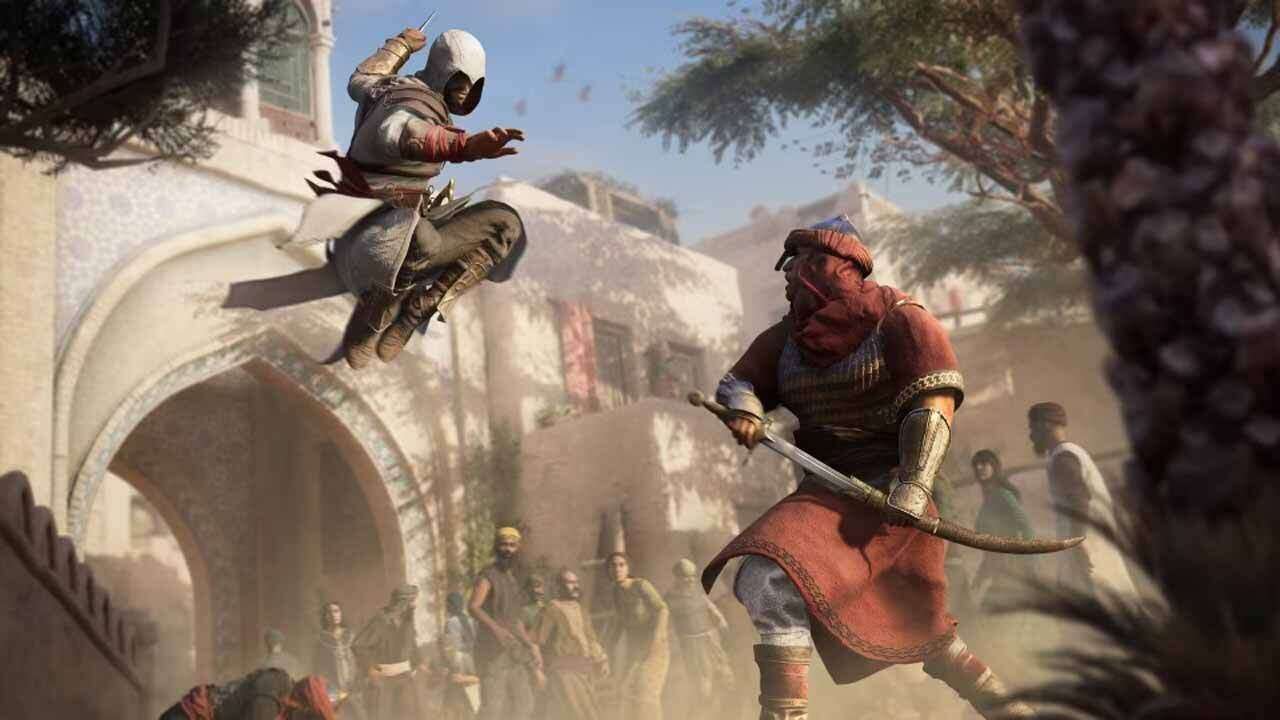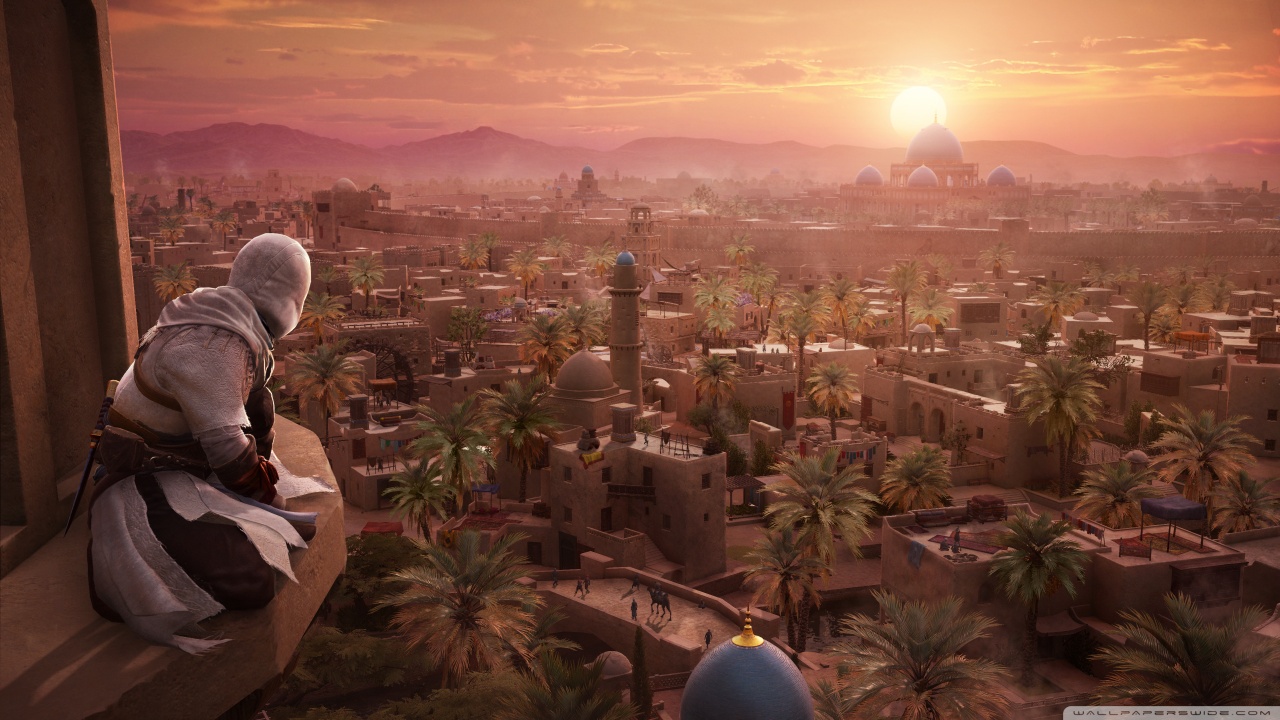Title – Assassin’s Creed Mirage
Platforms – PS5, PS4, Xbox Series X|S, Xbox One , PC
Release Date – October 5, 2023
Developer – Ubisoft Bordeaux
Publisher – Ubisoft
MSRP – $49.99
ESRB – M for Mature
PURCHASE ON AMAZON
Disclaimer – This product is being reviewed on the PS5. A review copy was provided by Ubisoft for this review. Minor spoilers for Assassin’s Creed Mirage and Assassin’s Creed Valhalla to follow. Gaming Instincts is an Amazon Affiliate and does gain financial benefits if you choose to purchase this product on this page.
The Assassin’s Creed franchise comes in all shapes and sizes, often diverging from the original concept. Mirage is an appeasement to the traditional fans, those who miss the assassins of yore. I’m one of those people. Someone disappointed in the bloated and massive open world of modern Assassin’s Creed, a world where Vikings and mercenaries take center stage. Putting on your hood, blending with a crowd, and keeping your presence anonymous have been replaced by cutting people down with a giant, two-handed axe.
Ubisoft Bordeaux saw fans like me and crafted a love letter to the original concept of Assassin’s Creed. A rest stop until the series goes big and bombastic with the next game set in Feudal Japan, Assassin’s Creed: Codename Red. Assassin’s Creed Mirage succeeds in capturing the tone and gameplay of the original games, but, with it initially, being an Assassin’s Creed Valhalla expansion, a lot of the design, specifically parkour and combat, wasn’t made for such an experience.
In reality, Mirage combines Assassin’s Creed 1, 2, and Valhalla, bringing in the concepts of 1 and 2 and infusing them with Valhalla game design. It goes back to the roots and modernizing those roots. I’m glad Ubisoft embarked on the experiment, and even though the game has some problems, it was a joy to feel like an Assassin again.
The Story: Mistaking Shadows for Light
Going into Mirage, the discourse was around gameplay as opposed to its broader connection to the franchise. Getting to play Basim Ibn Ishaq, and learning about how he became an assassin is a big deal. Basim was introduced in Valhalla as the Master Assassin who accompanied Eivor and their Viking crew. He later became a central character in the story, which drove the plot to its finishing line. Basim is essential for the future of the Assassin’s Creed meta-narrative.
It’s understandable why playing as Basim didn’t seem like a big deal to the broader crowd. Valhalla is over 100 hours long, and most casual players probably didn’t stick with the narrative to see what Basim is about. With that said, playing Basim is exciting because we get to know the background of one of the main characters going forward in the franchise. It’s risky to say this publicly, but I like the present-day (or sci-fi) narrative of Assassin’s Creed. It’s the convoluted thread that has stitched every game together.
Mirage does not shy away from this, and that’s a good thing for Assassin’s Creed purest. Ever since the beginning, Assassin’s Creed has had an underlying sci-fi that’s important without being too intrusive. I would say that given the importance of modern-day storytelling, particularly in Mirage, I was disappointed with the sci-fi twist at the end. It was cheesy and failed to drop any franchise-altering bombshells like in Valhalla. However, most will be glad to know there are no modern-day gameplay segments. (I’m not sure who is even in the Animus.)
Let’s turn away from the sci-fi nonsense and discuss what most people care about – the historical, grounded side of Assassin’s Creed. Mirage is Basim’s game. The overarching narrative of assassinating members of the order (or the Templars) is not too complicated. However, the exploration of Basim’s inner struggle to recognize who he is – that’s the meat of the narrative.
You don’t start as an Assassin but as a street thief in 9th-century Baghdad. Historically, the Assassins (or Hidden Ones) have partnered with thieves to help with their exploits. Ezio, from Assassin’s Creed 2, for example, would pay thieves to distract guards. I loved getting to see things from the other perspective. Basim started jobs for the Hidden Ones, which set him on a path to become an Assassin himself.
It’s been a while since we’ve seen a simple storyline of someone becoming an Assassin, training to be an Assassin, and then raising the ranks of the order. It was refreshing to focus on the Creed. It was like returning to a long-lost friend. However, now that I’m older, I know the Assassins are not simply a badass group of good people who kill bad people. There is more nuance, and Basim must figure out how he fits in.
In the beginning, we get a voice-over by William Miles, a long-term character for the franchise. He says we can’t “mistake the shadows we walk for the light we serve.” I loved that line. It perfectly sums up the central struggle of Mirage, specifically, the different viewpoints of the past. Basim’s master Roshan, taught him to let his past go because as an assassin, he is a new creation. The past no longer defines him. Basim’s friend and fellow thief, Nehal urged him not to forget where he came from and encouraged him not to let his master define his identity. I wasn’t expecting such a mental deep dive for the hook of the narrative, but it was a welcome surprise.
Basim is a great character. Young, charming, and serious when he needs to be. I was disappointed that we didn’t get much of a connection with any of the other characters. They mostly served as a plot device. We see they are close to Basim, but we don’t know why. For instance, a training montage of Basim’s time with the Assassins sped past a large portion of time. After that, he and the other assassins act like family, but we don’t get to see that develop or get to know the assassins working alongside you.
The only other character we get some time with is Roshan. Despite being a cool character with excellent voice-over work by Shohrey Aghdashloo, we never learn much about her past or get to know her beyond the role of Basim’s master. However, I’d argue that’s the point. She is so engrained with the Assassin’s Order that she would follow the code to a T, no matter what. She wanted the best for Basim and was teaching them the only way she knew how. So Basim and Roshan are the highlights, for they both represent the struggle for identity and the things that form a person.
There is also a narrative of uncovering the Order as they corrupt Baghdad from the shadows. Each Order member, or assassination target, has a mini-storyline, as you unravel their exploits and unearth the truth of corruption in the city. None of your targets are memorable, but the mystery surrounding them is intriguing as you put on your detective hat and uncover the hidden threads of Baghdad. These investigations work best when you have several characters who could be part of the Order and you must figure out how they tie into the broader work of the antagonistic group. There are several small reveals about the intentions or alignment of a character that worked well.
Before moving on, I wanted to comment on the writing. Several lines were so good that I paused the game to write them down. Lines like “We must not know the truth behind what we must do” and “It is best to keep the thorn in, or you will bleed dry.” One conversation Basim had with the governor illustrated the immature single-mindedness of the Assassins compared to the compromise required as you grow up. I’m not used to Assassin’s Creed hitting me with thoughtful one-liners, and I applaud the writing team for combining words in a thoughtful and impactful way.
Gameplay: Modernizing the Roots
The gameplay loop
Baghdad has four assassin bureaus, each associated with a different Templar threat. As you follow leads, which are essentially missions, you’ll uncover the target and an opportunity to assassinate them. The assassination missions usually take place in a huge building or section of town with several entry points and opportunities to get close to the target. They each act as the end of a chapter, a culmination of all your investigations and the ending of that particular storyline.
You can complete each investigation in any order, giving the player the power to choose which targets to go after. The investigation menu is your guide, a tab in the menu that lays out your progress in the story. Four Assassin symbols on each corner of the Investigation menu represented the different bureaus.
As you complete missions and uncover more about the target associated with each bureau, lines will branch out of the symbol and connect to another investigation opportunity. Sometimes you will find two clues, and two lines will branch out to two different opportunities. Complete all the investigations, and the main target will appear on the menu. After you take him out, his picture is slashed with blood, indicating the end of a particular investigation.
The investigation menu is a glorified quest log, but its layout represents active participation in solving a mystery, which helps it avoid the checklist nature of most open-world games. The motivation is no longer marking “done” on a quest and moving on to the next item on a to-do list. Instead, the motivation is completing a mission to unlock the next clue in an overarching investigation. I loved this approach to missions, as I never felt overwhelmed with how much I had to do, and its presentation was robust. A side quest in Valhalla gave you a diagram of Order members to take out. The investigation menu is like that, but if the whole game was based on that one side quest.
The gameplay loop may sound familiar to fans of Assassin’s Creed 1, for it was structured similarly: complete a series of investigations to unlock the big assassination mission. Whereas in the original, these mostly entailed eavesdropping, tailing, or pickpocketing individuals, the investigations in Mirage are objective or mission-oriented. For instance, it could have you sneaking into the postal office and reading a suspect’s mail. Other investigations could be helping a group of mercenaries escape their holding cells, or talking to merchants at the bazaar about a future auction.
Another thing that helps with the checklist slog is the discovery of objective locations. One time Roshan told me to meet her outside the biggest prison in Baghdad. I was looking at the map confused because I selected the investigation, but no icons appeared. Instead of being hand-held by an icon, I looked through the map for a big prison, marked it, and headed over. Surely enough, Roshan was there waiting for me. The concept of finding missions through clues and discovery is an exciting deviation in recent Assassin’s Creed games.
Sometimes you can bribe a merchant to tell you the exact location of a building, and it will then show up on your map with an icon. The game balances this well, sometimes telling you what to do and other times letting you figure it out. Once I got the hang of it, I could easily deduce my next location.
Stealth and Combat
Most investigations (or missions) involve stealth, the bread and butter of Mirage. I tell you what. It’s great to feel like an assassin again. In one mission, there was a large gathering of people, and I was blending with the crowd and using my eagle vision to locate the target. It makes no sense for a hooded man with a sword hanging on his heap to blend in, but that’s the Assassin’s Creed stealth I’ve missed. It’s unbelievable, but you feel like a trained master when you inconspicuously sneak into a party or sit on a bench and eavesdrop on a conversation.
As well as gathering intel, you will also take out soldiers with your hidden blade. I remember when crouching and hiding behind cover was introduced in Assassin’s Creed, and it was a godsend. Instead of awkwardly standing behind a thin pillar, you are now crouching behind a wall or box. Mirage combines the modern notion of crouching behind objects and hiding in tall grass with the old-style technique of hiding in crowds, or haybales.
In a stealth encounter, you could sneak up a rooftop, hide in a rooftop garden, and whistle. The guard will hear the whistle and walk over to investigate, only to get stabbed and pulled into the booth-like structure. You walk out like nothing happened and notice a guard standing next to some tall grass, work your way to ground level, and crouch walk to pull the unsuspecting guard into the grass while no one is looking.
Every encounter with a group of guards has several opportunities. You could throw your knife to cut down a box precariously hanging above some guards, throw a smoke bomb down and take out three guards at once, or sneak past everyone without killing them. However you play, there is one thread of feeling like an accomplished Assassin who strikes from the shadows. The thrill of thinking of a plan and executing it well will give you a sense of satisfaction every time you pull off an unscripted stunt.
The toolset helps accomplish these feats, and they are all basic distraction devices or traps. You won’t be getting an arrow that shoots through a wall or the ability to turn invisible. Every tool is feasible and grounded. The tools make you think about your approach, and give joy in the simplicity. For instance, I had to loot a box guarded by some soldiers. I hid behind a wall and threw a noise maker. The guards walked over, and I looted the chest without anyone noticing.
That may seem mundane, but the satisfaction of accomplishing the task unscathed with the most basic of tools feels much better and fits with the Assassin lore. You may think you could still use stealth in newer Assassin creeds like Odyssey and Valhalla. That’s true, but those games are not designed around stealth. Combat is a potential option in Mirage, however, the environments, story, and practicality of stealth encourage you to play in the shadows.
One may argue that you opt for stealth because the combat in Mirage isn’t that good. In my playthrough, combat was a last resort, only engaging in the open when I had to or messed up a stealth encounter. Basim has a sword and a dagger. He holds the dagger in one hand to parry and the sword in the other to attack. Essentially, every combat encounter boils down to waiting for the enemy to attack and parrying for an instant kill.
It’s not deep or complicated, and something about it seems off. It has the same design as Valhalla combat just adapted to fit with the less action-heavy approach in Mirage. Perhaps, Valhalla’s game design doesn’t translate to this style. I am glad there is an instant kill after parries because it encourages you to time your defense instead of running in yelling and mashing the attack button. Because you can dispose of individual enemies quickly, you can kill a guard in open combat and enter back into stealth without much hassle.
However, when multiple guards attack you at once, you end up looking more like a doofus than an Assassin. The lock-on feature doesn’t stay concentrated on a single enemy, so you end up swinging at an unintentional target. Other times, guards have extra army, so you awkwardly circle them until you can get one slash in on the back and repeat until their health bar goes down. I usually just ended up throwing a smoke bomb down and assassinating them while they coughed in confusion.
I think combat is designed specifically to make you use your tools or find a way to enter back into stealth. I’d rather it be this way than the other way around, but Assassin’s Creed has never created a good combat mechanic that also encourages you to play with stealth. It’s either a bad or awkward sword-fighting system that forces you into stealth because it wasn’t made well or an overpowered sword-fighting system that makes stealth seem like an inferior option. Mirage is an attempt to find that middle ground. It might be the closest the series has gotten, but it is not all the way there.
Assassination Missions
As I said, all these investigations lead to chapter-ending assassinations, the game’s highlight. They are a more linear take on Hit-Man, giving you different opportunities to approach your target or lead them into the open. One of these assassination missions took place in the House of Wisdom, the intellectual center of Baghdad. An astronomer giving a lecture about his discoveries was also my target. After the lecture, he scurried off to his hiding place after hearing word of an assassin running amuck.
So, I make my way into the House of Wisdom courtyards and overhear a group of people wondering where the lecturer went. I sat on a nearby bench and eavesdropped on the conversations, overhearing a rumor that there is a secret basement under the house of wisdom, and there is a way to enter through the garden. Intrigued, I head over to the garden, and, on the way, see a guard standing in front of a doorway, telling civilians they can’t enter.
I walked over to see what was going on and realized I needed a password. I now had two potential entrances to this rumored basement. I’m sure there was a way to find the password, but the garden hatchway was more intriguing. I sent my eagle soaring into the sky (yes, the eagle from Odyssey and Valhalla makes a return) to scout out the area. He spotted a guard with a key on top of the south end of the building. Knowing the secret hatchway was probably locked, I assumed this key was my way in.
With my newfound knowledge, I scurried up the side of the building, which no one thought was weird. Stealth killed some guards on the roof and pickpocketed the key, which required a timed button press. Key in hand, I found the hatch in the garden and entered the basement, ready for the evils that awaited.
Every big assassination plays out like this. There are multiple approaches based on the things you decide to investigate. Sometimes, you may even adorn a different costume to slip past the guards. The choice is up to you. The assassination is scripted, but the player’s approach will be different based on the leads they pursue.
I hope the franchise continues to evolve this sandbox, light sim approach. Although some might be upset by the lack of experimentation (you can’t throw a fish at your target’s head), the level of options works for the Assassin’s Creed franchise’s cinematic stealth experience.
Progression
Let’s zoom out a bit and see how progression works. How do you unlock these tools and assassination abilities? Briefly, it is barebones. You can tell that this was initially an expansion, not a full game. There are different avenues to progression, the most basic being your skills tree. The tree is divided into three sections: phantom, trickster, and predator. This is not a game where you carefully pick your skills and get locked out of others. You do not create a predator build, for example. There is enough XP to unlock everything in this minuscule tree.
The abilities are not anything to run home about, but that is what we were asking for right? A more grounded approach to Assassin’s Creed. You can increase the range of your eagle vision, unlock chain assassinations, or unlock throwing knife recovery. Every upgrade is helpful, making the game a bit more convenient.
Your tools can also be upgraded by collecting material from loot boxes around the map. One of my favorite upgrades was the ability to charge your knife throw, allowing for increased damage and range. Before the upgrade, I would see an opportunity to kill three guards standing around an explosive barrel like idiots, but I was out of range. When I got into range, they already walked away. However, with this knife upgrade, I can throw my knife from a safe distance perched on a rooftop. Upgrades like this do a good job of making you feel powerful in grounded ways.
The last category of progression is through armor and weapons. Don’t worry, this isn’t a convoluted loot system where you get plus-one damage because your sword is purple. It mostly comes into play with the perks certain weapons and armor have. I stuck with my Initiate of Alamut Sword because it has increased damage after a successful parry, letting me get out of combat quicker. Every sword is viable, and you won’t miss out if you don’t find a particular sword. It is based on player preference and playstyle, nothing else.
With all the talk about being grounded, one ability breaks the mold. Unlocked at a certain point in the story, you can teleport to multiple enemies and take them out at once. The animation clues me in that this is an Animus glitch. Ubisoft couldn’t help themselves. They had to put a superpower into the historical game, but I can’t deny it looks cool and was helpful in certain situations.
Some might find the lack of progression options and depth in customization as a detriment. But, for my preference in games, it was a nice respite from the onslaught of options that Valhalla gives you. Mirage is a barebones, by-the-book, open-world game. It just depends on what you are looking for. I would categorize Valhalla as an RPG, while Mirage is an open-world game.
Parkour
The open world may be so small that it could be considered an over-correction. I would liken it to Assassin’s Creed Brotherhood’s map, one big city with the wilderness surrounding it. Perhaps, Mirage would benefit from a few different maps, like how Assassin’s Creed 2 lets you travel to Venice, Florence, and other cities. I’m not here to talk about what could have been, but I wanted to warn fans that Mirage could be considered a lengthy expansion, not a full game.
However, what we do have is great. When I think about returning to its roots, it’s best seen through the city-centric map. Assassin’s Creed was known for its dense cities and parkour playground, not its wide swaths of empty lands. Baghdad is a beautiful city to explore with different areas diverging based on social class. There is a differentiation between the taller, more embroidered buildings of the Round City and the small buildings in Anbar.
One of Assassin’s Creed’s best features is the city designs and their historical authenticity. Simply by re-creating magnificent, hand-made structures, Assassin’s Creed is home to some of the best locales in gaming. Mirage is no different.
The city is built for parkour, giving you easy ways up buildings, zip lines to slide down, and strategically placed hand-holds to grab onto. To my enjoyment, parkour was a puzzle, not automatic. I love looking at an environment and finding the best way to climb to my desired location. I liken it to Marvel’s Spiderman where the swinging is so fun that you opt out of fast traveling. Assassin’s Creed Mirage is the same way, but, unfortunately, a Valhalla stain sneaks its way in.
Just like the combat, the parkour is taken straight from Valhalla but restructured around old-school Assassin’s Creed. Essentially, Basim climbs the same way as Eivor, except he is inside the jungle gym of a city, and must aim and press “X” to jump. Valhalla parkour was not designed for this. The result is a movement that feels slightly off. My inputs wouldn’t always translate to the screen, or I would intend to jump to a ledge, but Basim would jump in the opposite direction.
This is not that frustrating when parkouring around the city because you can keep going the alternative route without repercussions. Combat, however, is a different story. One time I was jumping to a nearby ledge to avoid detection from the guards below, but instead of jumping to the ledge, which was well in range, Basim jumped straight down in the middle of the circle of guards. Things like this happen too often, and you can usually improvise your way out of it, but it shouldn’t be a problem in the first place.
Visuals and Audio: Beautiful Ubisoft Jank
Mirage can be played in both High Framerate and Quality mode on the PlayStation 5. I opted for the High Framerate mode, which prioritizes 60 FPS, and it was generally smooth, except for some exceptionally low frame drops. It only happened about three times in stealth gameplay. The frames would suddenly drop to choppy levels for a few seconds. I’m not sure why that was, and I could see it being troublesome if it happened more. I can’t say if other players will or will not experience that to the same extent I did.
As expected, the visuals are stunning in both modes. Watching the wind swirl sand around in the wilderness and seeing the majestic city in the distance was especially enchanting. You will only load the game for about 5 seconds after starting it. Besides that, most loading is gone or hidden. Every time I opened the door to a bureau, I expected a loading screen but was impressed whenever Basim walked straight in.
Lastly, you can’t talk about Assassin’s Creed audio without mentioning the re-envision of the Ezio theme. The theme was so good in Assassin’s Creed 2 that it has become the theme song for the series; every game included it in a different form. When this plays, the hype and nostalgia settle in and transcend all critical thinking. If that song plays, I immediately think Mirage is the best game ever, like when a soft piano reinforces a speech, and all of a sudden it’s the best speech you’ve heard. Assassin’s Creed never disappoints with its soundtrack, and Mirage is no exception.
Final Verdict
One of the best compliments I can give Mirage is that it took me 20 hours to beat, not 100. Nothing about the game is intimidating, from the map size to the progression system. It’s a callback, not only to old-school Assassin’s Creed but also old-school open-world games in general. There is no hiding that Mirage was once an expansion but I will take it over a bloated open world any day.
If you are an Assassin’s Creed purest, then Mirage is not exactly what you are looking for. It doesn’t bring back Assassin’s Creed of yore but modernizes several of the mechanics we came to love. Unfortunately, they are hindered by a design that simply wasn’t meant for the system it evoked. Still, for those looking for a smaller Assassin’s Creed game with a focus on assassins, Mirage gets the job done. Assassin’s Creed Mirage receives a final verdict of 8.0 out of 10.
Stay tuned at Gaming Instincts via Twitter, YouTube, Instagram, and Facebook for more gaming news.








